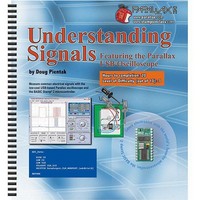70009 Parallax Inc, 70009 Datasheet - Page 43

70009
Manufacturer Part Number
70009
Description
BOOK UNDERSTANDING SIGNALS
Manufacturer
Parallax Inc
Type
Signal Analysisr
Datasheet
1.70009.pdf
(137 pages)
Specifications of 70009
Style
Book
Title
Understanding Signals
Contents
Guide to Generate, View and Measure Wave Forms
Product
Microcontroller Accessories
Lead Free Status / RoHS Status
Not applicable / Not applicable
Other names
70009PAR
Available stocks
Company
Part Number
Manufacturer
Quantity
Price
Company:
Part Number:
700090B
Manufacturer:
COPAL
Quantity:
5 510
Company:
Part Number:
70009CB
Manufacturer:
VISHAY
Quantity:
5 510
Part Number:
70009GB
Manufacturer:
TI/PHILIPS
Quantity:
20 000
Chapter #3: Sine Waves
SINE WAVES WITH THE BASIC STAMP FREQOUT COMMAND
A sine wave is a common electrical signal that can be viewed on the OPTAscope. Unlike
digital signals that typically are either high or low, analog signals can be high, low, or
any value in between. One of the most common types of sine waves that we can sense is
the sound wave. Sound waves permeate the air in three dimensions in the same manner
that ripples flow across a pond in two dimensions. A cross-section of the surface of this
pond would look something like the waveform in Figure 3-1.
Despite the fact that BASIC Stamps are digital by their nature, they can generate sine
waves. The interesting thing here is how they generate sine waves. The BASIC Stamp
must approximate the sine wave with a sequence of digital square waves that is later
filtered into a nice, clean sine wave. When you connect a piezoelectric speaker to a sine
wave you will hear a tone (provided the sine wave is oscillating at a frequency within the
audible range). This may sound confusing, but it will clear up as we work through the
next lesson. First, we need a little more background information.
The pulse train used to control servos is only one type of signal in a family of signals
called PWM. PWM stands for pulse width modulation. The servo pulse train is unique
in that it has a fixed “off-time”. Most PWM signals have variable off-time as well as
variable on-time. Consider the pulse train depicted in Figure 3-2.
Figure 3-1:
Typical sine wave – one cycle.
Figure 3-2:
PWM signal
train



















